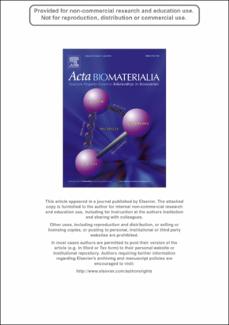Mostrar el registro sencillo del ítem
A review on the wettability of dental implant surfaces II: Biological and clinical aspects
| dc.contributor.author | Gittens, Rolando A. | |
| dc.contributor.author | Scheideler, Lutz | |
| dc.contributor.author | Rupp, Frank | |
| dc.contributor.author | Hyzy, Sharon L. | |
| dc.contributor.author | Geis-Gerstorfer, Jürgen | |
| dc.contributor.author | Schwartz, Zvi | |
| dc.contributor.author | Boyan, Barbara D. | |
| dc.date.accessioned | 2020-08-08T19:03:25Z | |
| dc.date.available | 2020-08-08T19:03:25Z | |
| dc.date.issued | 2014-04-05 | |
| dc.identifier.other | doi.org/10.1016/j.actbio.2014.03.032 | |
| dc.identifier.uri | http://repositorio-indicasat.org.pa/handle/123456789/231 | |
| dc.description | Dental and orthopedic implants have been under continuous advancement to improve their interactions with bone and ensure a successful outcome for patients. Surface characteristics such as surface topography and surface chemistry can serve as design tools to enhance the biological response around the implant, with in vitro, in vivo and clinical studies confirming their effects. However, the comprehensive design of implants to promote early and long-term osseointegration requires a better understanding of the role of surface wettability and the mechanisms by which it affects the surrounding biological environment. This review provides a general overview of the available information about the contact angle values of experimental and of marketed implant surfaces, some of the techniques used to modify surface wettability of implants, and results from in vitro and clinical studies. We aim to expand the current understanding on the role of wettability of metallic implants at their interface with blood and the biological milieu, as well as with bacteria, and hard and soft tissues | en_US |
| dc.description.abstract | Dental and orthopedic implants have been under continuous advancement to improve their interactions with bone and ensure a successful outcome for patients. Surface characteristics such as surface topography and surface chemistry can serve as design tools to enhance the biological response around the implant, with in vitro, in vivo and clinical studies confirming their effects. However, the comprehensive design of implants to promote early and long-term osseointegration requires a better understanding of the role of surface wettability and the mechanisms by which it affects the surrounding biological environment. This review provides a general overview of the available information about the contact angle values of experimental and of marketed implant surfaces, some of the techniques used to modify surface wettability of implants, and results from in vitro and clinical studies. We aim to expand the current understanding on the role of wettability of metallic implants at their interface with blood and the biological milieu, as well as with bacteria, and hard and soft tissues | en_US |
| dc.format | application/pdf | |
| dc.language.iso | eng | en_US |
| dc.rights | Info:eu-repo/semantics/openAccess | |
| dc.rights | https://creativecommons.org/licenses/by/4.0/deed.es | |
| dc.subject | Surface energy Hydrophilicity | en_US |
| dc.subject | Osseointegration Titanium | en_US |
| dc.subject | implant roughness Surface conditioning | en_US |
| dc.title | A review on the wettability of dental implant surfaces II: Biological and clinical aspects | en_US |
| dc.type | info:eu-repo/semantics/article | en_US |
| dc.type | Info:eu-repo/semantics/publishedversion |

